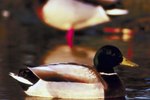Brightly colored hummingbirds bring hours of entertainment, but that can all end if your feeder is dripping nectar on the ground. The first step is to choose a feeder that's less likely to leak. Then, figure out how to fix small leaks.
Why Feeders Leak
Several factors cause that maddening dripping from the feeder onto your deck or patio. The weather comes into play, as does the design of the hummingbird feeder. Both have fixes.
Poor Seal
If a bottle feeder's base and bottle aren't properly screwed together, nectar can leak. After inverting the feeder so the bottle's neck is on the bottom, check the connection to ensure it's secure. If necessary, turn the feeder back up and undo and recouple the base and bottle.
Because hummingbirds often feed in summer, sun damage can affect the feeder. If you find cracks or holes in the feeder, it has been compromised. Replacing the feeder is your best bet.
Keep It Clean
If you've inadvertently left some sugar crystals around the feeder's seals and seams, air can get into those tiny gaps and lead to leaks. Cleaning the feeder with soap and water, and rinsing thoroughly should alleviate this problem.
Too Much Sun
If your feeder is always in the sun, the air above the nectar can become hot. The air expands, forcing the nectar out of the ports and causing the nectar to drip out. Remedy this problem by placing the feeder in the shade.
Wildlife Problems
Other birds, squirrels and raccoons could find your hummingbird nectar appealing. By perching on or near the feeder and jostling it around, these animals might cause the nectar to leak. To solve this problem, remove nearby tree branches, trellises or other objects that might provide a jumping-off spot to the feeder.
Feeder Leak Potential
Not all hummingbird feeders have the same potential for leakage. By knowing which feeders are more likely to drip, and taking appropriate action, you can spend less time cleaning up nectar and more time watching hummingbirds.
Bottle-Type Feeders
Bottle-style hummingbird feeders often feature attractive colors and styles. But bottle-type feeders are prone to heat-related air expansion that pushes nectar out through the ports. By moving the feeder into a shadier spot, you'll solve this problem and reduce the nectar's chance of spoilage.
Saucer-Type Feeders
A well-made saucer-type feeder shouldn't leak. Because its feeder ports are higher than the liquid level, the liquid can't physically drip onto the ground. In addition, this style of feeder shouldn't splash even in a strong wind that moves it back and forth.
Hummingbird Feeder Features
When choosing hummingbird feeders, look for features that will benefit the hummingbirds and make cleaning easier.
Bright Red
Because hummingbirds are attracted to red, choose a feeder with a red base or accents.
Built-In Perch
Although hummingbirds are adept at hovering while they feed, a feeder with a perch enables them to rest while they eat.
Rain Guard
If your feeder contains ports on top of the reservoir, rainwater can potentially run into the ports and dilute the nectar. A rain guard prevents this.
Ant Moat
A water-filled ant moat prevents hungry ants from getting to your hummingbirds' nectar. Although many feeders contain a built-in moat, bird feeding stores and online retailers also sell add-on ant moats.
References
Writer Bio
Based in North Carolina, Felicia Greene has written professionally since 1986. Greene edited sailing-related newsletters and designed marketing programs for the New Bern, N.C. "Sun Journal" and New Bern Habitat ReStore. She earned a Bachelor of Science in business administration from the University of Baltimore.




